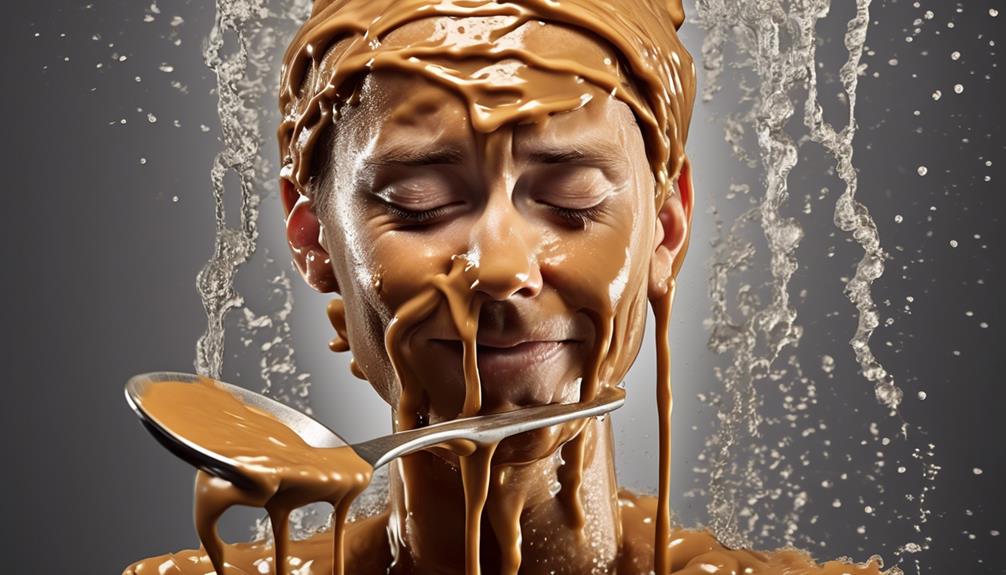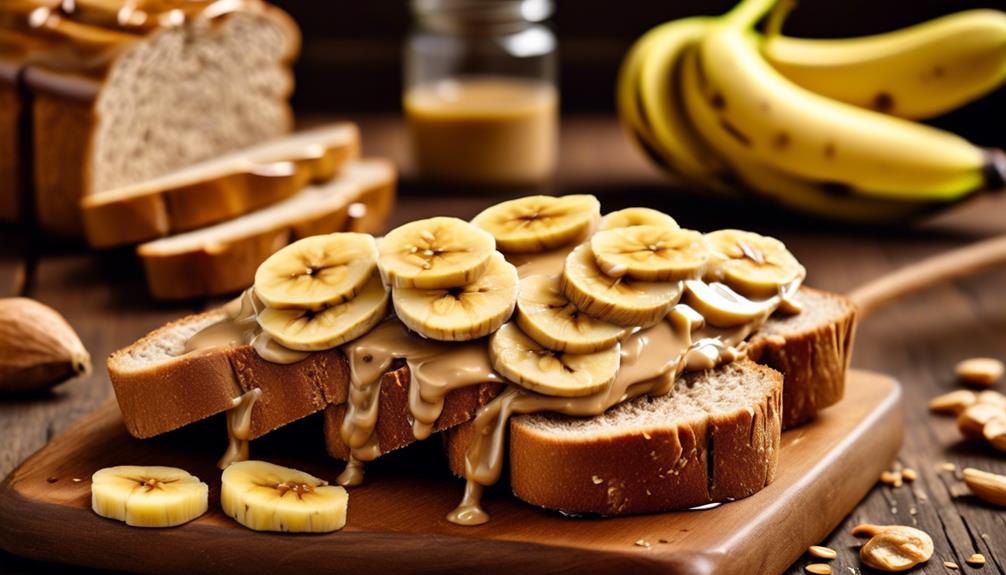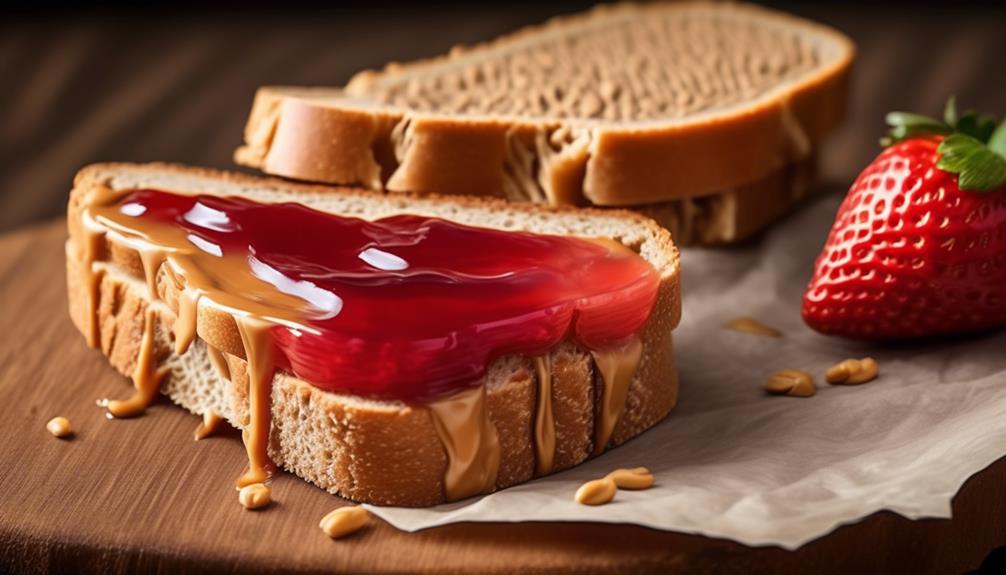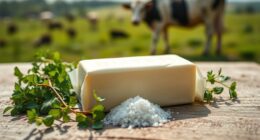The saying goes that ‘cleanliness is next to godliness,’ and when it comes to cleaning up peanut butter, we’ve all faced the same situation – looking at a jar with leftover creamy spread, wondering how to handle the job.
It's a common conundrum, but fear not, there are numerous approaches to this sticky situation. From classic methods like using a glass of milk to more unconventional ideas like creating a smoothie sensation, the options are varied and intriguing.
So, how exactly do you wash down peanut butter? Well, let's just say there's more than one way to solve this culinary puzzle.
Key Takeaways
- Pairing peanut butter with a glass of milk is a classic and effective way to wash it down.
- Thoroughly washing surfaces with warm, soapy water and paying attention to seams and crevices helps remove peanut butter residue.
- Vinegar can be used as a natural alternative to dish detergent for cleaning peanut butter jars.
- Properly drying the jar after washing is essential to prevent mold or bacterial growth.
The Classic: Glass of Milk
We have found that pairing peanut butter with a cold glass of milk is a classic and effective way to wash down peanut butter due to the natural emulsifiers present in milk.
When the peanut butter jar needs cleaning, hot water is a simple and efficient way to clean out a peanut butter jar and minimize waste. The hot water melts the residual peanut butter, making it easier to scoop out and wash away.
It's crucial to understand the role of fat content in milk when washing down peanut butter. The fat in the milk can affect the ease of washing down the peanut butter. Different milk fat contents can be experimented with to study their effect on washing down peanut butter.
This classic combination of peanut butter and milk highlights the unique behavior of milk in washing down peanut butter, thanks to its emulsifiers. The interaction between the peanut butter and milk creates a satisfying and smooth experience, making it a go-to choice for many.
Water, Water, Everywhere

Water is a crucial ingredient in the process of washing down peanut butter. It helps to remove the sticky residue from the mouth and throat, allowing for easier swallowing.
Additionally, understanding the proper drying process after washing down peanut butter is essential to prevent any potential discomfort.
Water and Peanut Butter
When cleaning a peanut butter jar, using a rubber spatula to remove any remaining peanut butter is an effective first step.
Then, fill 1/4 of the jar with hot water and add a drop of dish soap. Screw the top back on and shake to clean the jar effectively.
Consider using vinegar as a natural alternative to dish detergent for cleaning.
Water plays a crucial role in cleaning peanut butter jars, as it helps to loosen the stubborn remnants of peanut butter, making it easier to clean. Additionally, water is essential for creating a soapy solution that aids in breaking down the oils in the peanut butter.
With these steps, water becomes an indispensable tool in maintaining cleanliness and hygiene when dealing with peanut butter residue.
Washing Technique
Utilizing a gentle scrubbing motion with a sponge and warm, soapy water facilitates the effective removal of residual peanut butter from surfaces. This technique is essential for maintaining cleanliness and preventing cross-contamination. It's important to use a gentle touch to avoid damaging the surface while ensuring thorough removal of all peanut butter remnants.
When washing down peanut butter, it's crucial to pay attention to details, such as seams and crevices where peanut butter residue can hide. Ensuring the removal of all peanut butter is vital to prevent potential allergen exposure and maintain a hygienic environment.
Additionally, rinsing surfaces with clean water after washing helps to eliminate any remaining soap and peanut butter residue, providing a safe and clean area for food preparation or consumption.
Drying Process
After ensuring thorough removal of all peanut butter remnants, the drying process is crucial to prevent mold or bacterial growth in the jar. To achieve optimal drying, consider the following techniques:
- Air Dry: Allow the jar to air dry completely before storing, ensuring that all moisture evaporates.
- Pat Dry: Use a clean cloth or paper towel to gently pat the jar dry, expediting the drying process.
- Utilize a Dish Rack: Place the jar on a dish rack to facilitate air circulation for thorough drying.
These methods will help to ensure that the jar is completely dry before sealing, preventing any potential for mold or bacterial growth.
For those seeking a quicker option, a hairdryer on a low setting can be utilized to expedite the drying process, though thoroughness is key to maintaining a mold-free environment.
Smoothie Sensation

To create a delicious and nutritious smoothie, we can choose from a variety of fresh fruits and vegetables and blend them with a liquid base such as almond milk, coconut water, or yogurt to achieve the desired consistency.
By incorporating fruits like berries, bananas, and mangoes, and vegetables such as spinach or kale, we can ensure a rich infusion of essential vitamins, minerals, and antioxidants.
Adding nutritional boosts like chia seeds, flaxseeds, or protein powder can further enhance the smoothie's health benefits, providing omega-3 fatty acids, fiber, and protein.
When blending the ingredients, it's crucial to ensure a smooth and creamy texture, adjusting the thickness as needed by incorporating more liquid or frozen ingredients.
To serve, pouring the smoothie into a glass and topping it with additional fruits, nuts, or seeds can add extra texture and visual appeal.
This delightful, nutrient-packed beverage provides a convenient and enjoyable way to consume a variety of essential nutrients, making it a perfect addition to any health-conscious individual's routine.
Tea Time Solution

Let's talk about the health benefits of incorporating tea into your daily routine.
The antioxidants in tea can help reduce the risk of chronic diseases and boost your immune system.
Additionally, the ritual of tea time can provide a calming and relaxing break in your day.
Peanut Butter Removal
In our quest for an effective solution to remove peanut butter, we've discovered a method that incorporates the soothing ritual of tea time. After extensive experimentation, we found that the combination of tea and a few simple ingredients can effectively remove peanut butter residue from various surfaces. Here's how we do it:
- Prepare a cup of hot black tea: The tannins in black tea work as a natural cleansing agent, helping to loosen the peanut butter residue.
- Add a splash of vinegar: The acidity of vinegar aids in breaking down the fats in the peanut butter, making it easier to remove.
- Sprinkle some baking soda: This gentle abrasive helps to lift off the stubborn peanut butter remnants without causing any damage.
This method not only effectively removes peanut butter but also provides a calming and aromatic experience, making the task a delightful part of your day.
Tea Stains Solution
Our recommended solution for removing tea stains, also known as the Tea Time Solution, involves utilizing a mixture of white vinegar and water to soak tea-stained items such as cups and teapots. The acidic nature of white vinegar helps to break down the tannins in the tea, while water aids in dilution.
After soaking, gently scrub the stains with a soft brush or sponge, ensuring thorough rinsing afterwards. For stubborn stains, a paste made from baking soda and water can be applied, left to sit, and then scrubbed off before rinsing.
It's essential to completely dry the items to prevent further staining. This method is effective and environmentally friendly, providing a simple and practical solution for maintaining tea-stained items in our daily lives.
Gentle Washing Technique
Utilizing the same gentle washing technique employed in the Tea Stains Solution, we can effectively remove peanut butter residue from jars by filling them with warm water and a drop of dish soap to loosen the residue. Then, we can follow these steps:
- Gently scrub the jar with a soft sponge or cloth, avoiding harsh abrasives that could scratch the glass.
- Thoroughly rinse the jar with warm water to ensure all soap and peanut butter remnants are removed.
- Dry the jar with a soft, clean towel to prevent water spots and ensure it's ready for reuse.
This method ensures the jar is impeccably clean, ready to hold your favorite tea.
Embracing the gentle washing technique provides a sense of care and consideration for the items we use daily, enhancing our overall tea-drinking experience.
Juicy Juice

Offering a range of flavors and packaging options, Juicy Juice is a 100% fruit juice brand that provides a convenient and nutritious choice for families seeking a natural source of Vitamin C without added sugars or artificial additives.
Juicy Juice stands out as a wholesome option due to its commitment to using 100% fruit juice without added sugar or high fructose corn syrup. The brand's diverse flavor options, including apple, grape, fruit punch, and orange tangerine, cater to various taste preferences.
Additionally, the availability of Juicy Juice in bottles, juice boxes, and pouches makes it suitable for on-the-go consumption or inclusion in lunchboxes. Parents can feel confident in serving Juicy Juice to their children, as it contains no artificial preservatives, colors, or flavors. Furthermore, it serves as a good source of Vitamin C.
For families seeking an organic choice, Juicy Juice also offers organic options made from organically grown fruit. With its dedication to providing natural, nutritious fruit juice, Juicy Juice is a reliable option for those looking to incorporate healthy beverages into their daily routines.
Creamy Coffee

To create a creamy coffee, start by brewing a strong cup of your favorite coffee. Once you have your hot coffee ready, warm up some milk or a milk substitute in a separate container. Then, pour the warm milk into the coffee to create a luxurious, creamy texture.
Next, add a spoonful of your preferred sweetener for an extra burst of flavor. Stir the mixture well to ensure that the milk and coffee blend harmoniously, creating a delightful creamy coffee experience.
As we indulge in creamy coffee, the combination of the rich, bold coffee and the velvety smoothness of the warm milk creates a truly satisfying beverage. The addition of a sweetener enhances the flavor profile, elevating the experience to one of pure indulgence.
This creamy coffee not only provides a comforting warmth but also a delightful treat for the taste buds. It's a perfect way to start the day or to enjoy a relaxing moment of comfort and luxury.
Hydration Station

At Hydration Station, we prioritize the importance of staying well-hydrated. Our drinks are carefully formulated to provide essential hydration, energy, and nutrients.
Whether you're looking to replenish after a workout or simply need a refreshing beverage, our menu offers a variety of options to support your hydration needs.
Water and Soap
When cleaning a peanut butter jar, it's advisable to fill it with hot water and add a drop of dish soap to effectively remove residue. This method helps to break down the oils and sticky remnants left behind by the peanut butter.
After allowing the soapy water to sit for a few minutes, use a sponge or brush to scrub the jar's interior, ensuring that all surfaces are thoroughly cleaned.
Rinse the jar thoroughly with clean water to ensure all soap and peanut butter are removed, and then allow the jar to air dry completely before using it again.
If preferred, and if the jar is dishwasher-safe, consider using a dishwasher for cleaning. This ensures that the jar is hygienically clean and ready for its next use.
Rinse Thoroughly
After loosening the peanut butter residue by filling the jar with hot water and allowing it to sit, thoroughly scrub the interior using a bottle brush or sponge to ensure all remnants are removed.
It's crucial to rinse the jar with hot water, ensuring that all soap and peanut butter residue is completely removed. This step is essential in preventing any lingering flavors or residues from contaminating the next use.
Once rinsed, allow the jar to air dry completely before using it again. It's important to note that repeating the rinsing process may be necessary to ensure the jar is thoroughly clean.
Fizzy Fix

We can achieve a fizzy cleaning solution by dropping a Fizzy Fix tablet into a jar filled with water and allowing it to dissolve. This creates a powerful cleaning agent that effectively removes peanut butter residue and leaves the jar fresh and ready for reuse.
- Drop the Fizzy Fix tablet into the water-filled jar and watch it fizz as it dissolves, releasing its cleaning power.
- Use a brush or sponge to scrub the jar with the fizzy solution, ensuring that all areas are thoroughly cleaned and any stubborn peanut butter remnants are lifted away.
- Rinse the jar thoroughly with water to remove any residue, leaving it sparkling clean and free from any cleaning solution.
Using Fizzy Fix not only makes cleaning your peanut butter jars an easy task, but it also ensures that they're sanitized and free from any lingering traces of peanut butter. This method provides a simple and effective way to keep your jars in pristine condition, ready for the next use.
Coconut Water Craze

The current trend of coconut water consumption reflects a growing preference for natural and hydrating beverages with high potassium content. Coconut water has gained popularity as a post-workout hydration choice due to its electrolyte-replenishing properties. It is also favored for its refreshing taste and natural hydration benefits. This tropical beverage has become a staple in many people's diets, often used as a base for smoothies and cocktails. Additionally, the availability of flavored coconut water options caters to diverse taste preferences, further adding to its appeal.
| Benefits | Flavored Options |
|---|---|
| High potassium content | Mango |
| Natural electrolytes | Pineapple |
| Hydrating properties | Passion Fruit |
Coconut water is not just a fad; it is a nutritious and delicious beverage that offers a natural way to stay hydrated. With its potassium-rich composition and natural electrolytes, it stands out as a satisfying alternative to sugary drinks. The coconut water craze is not just a passing trend but a reflection of our collective desire for healthier, more natural beverage options.
Herbal Infusion

Indulge in the aromatic and beneficial experience of herbal infusion by selecting your preferred herbs and steeping them in hot water for 5-10 minutes. Choose from a variety of herbs such as chamomile, peppermint, or lavender, each offering unique flavors and potential health benefits.
Prepare the herbs by rinsing them under cold water to remove any dirt or debris, ensuring a clean and pure infusion. Heat the water to boiling point and pour it over the herbs in a heatproof container, allowing the hot water to extract the essential oils and compounds from the herbs.
Let the herbs steep in the hot water for the recommended time to infuse the water with their flavors and potential health-promoting properties. Finally, strain the herbs from the water and savor the resulting herbal infusion, whether enjoyed hot or cold.
This simple yet delightful process allows for a moment of tranquility and wellness, as you embrace the soothing essence of your chosen herbal blend.
Frequently Asked Questions
How Do You Remove Peanut Butter From Clothes?
We remove peanut butter from clothes by following these steps:
- Scrape off excess peanut butter.
- Apply a stain remover or liquid laundry detergent directly to the stained area.
- Gently rub the fabric together to work the detergent in.
- Wash the clothing in the hottest water temperature safe for the fabric.
- After washing, check to ensure the stain is completely removed before drying.
What Breaks Down Peanut Butter?
Soap and water effectively break down peanut butter by emulsifying the fats and lifting the residue.
Vinegar also serves as a cleaning agent, aiding in dissolving the peanut butter.
Scrubbing with eggshells, involving your dog, or enjoying it with ice cream can also help remove the residue.
These methods provide practical and safe ways to clean peanut butter containers, maintaining hygiene and preventing waste.
How Do You Get Peanut Butter Out of the Bottom of a Jar?
How do we get peanut butter out of the bottom of a jar?
Scraping with a rubber spatula is effective.
Then we can fill 1/4 of the jar with hot water and a drop of dish soap, shaking it.
Alternatively, we can use vinegar and hot water, or eggshells with hot water to scrub off the peanut butter.
Another option is giving the jar to a dog to lick clean, ensuring safety precautions are taken.
Why Is Peanut Butter Hard to Clean?
Peanut butter is hard to clean because of its thick, sticky consistency. The oils and proteins in peanut butter can form a stubborn residue.
To wash it down effectively, we recommend using warm, soapy water and a scrubbing brush to break down the oils and proteins. It's important to use hot water to help dissolve the peanut butter, making it easier to clean.
Additionally, soaking the utensils or jar in hot, soapy water can help loosen the residue.
Conclusion
In conclusion, there are numerous ways to wash down peanut butter, each with its own benefits.
Whether it's a classic glass of milk, a refreshing glass of water, or a nutritious smoothie, there's a method for everyone.
Remember, variety is the spice of life, so don't be afraid to try different options to find what works best for you.
After all, there's more than one way to skin a cat!
Stay hydrated and enjoy your peanut butter in whatever way suits you best.









